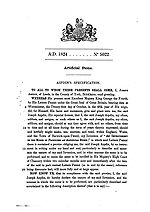- Joseph Aspdin
-
Joseph Aspdin (décembre ?1778 - 20 mars 1855 à Wakefield) était un inventeur anglais.
Biographie
Il était, à l'origine, un briquetier de Leeds.
En 1824, il dépose le brevet d'un ciment, en réalité un ciment prompt naturel, alors appelé chaux éminemment hydraulique en France, qu'il appelle "ciment Portland". Le nom de Portland avait été choisi pour bénéficier de la réputation qu'avait la pierre de Portland, dont les carrières sont pourtant situées à plusieurs centaines de kilomètres de Leeds[1].
Joseph Aspdin dira qu'il avait découvert le principe du ciment Portland dès 1811 pour lui donner une antériorité par rapport aux travaux de Louis Vicat, parus en 1818.
N'ayant pas de connaissances en chimie, les termes du brevet décrivant le procédé de fabrication du ciment sont assez vagues, ce qui fait douter que Aspdin avait une bonne compréhension de ce qu'il avait découvert. Et, les recherches sur les chaux hydrauliques et ciments naturels (appelés roman cement en Angleterre) datent de la fin du XVIIIe siècle.
C'est son fils, William Aspdin (en:William_Aspdin), qui va développer la fabrication du ciment Portland à Rotherithe (en:Rotherhithe) à partir de 1838. William Aspdin va proposer à Marc Isambart Brunel d'utiliser le ciment Portland pour boucher les venues d'eau du premier tunnel sous la Tamise (en:Thames foot tunnel) (1825 - 1843), pendant le terrassement à l'abri d'un bouclier, et en assurer l'étanchéité. Ce sera la première utilisation importante du ciment Portland pour un ouvrage de génie civil : mais il s'agit probablement de ciment prompt naturel (les procédés de cuisson à haute température, 1450 °C, des ciments artificiels lents ou portlands ayant été découverts en 1840 et 1850).
Notes et références
- Le terme de Portland sera conservé pour tous les ciments CEM I et CEM II suivant les notations de la norme EN 197-1. Le ciment Portland est un mélange de clinker et de sulfate de calcium dans un rapport 95-5% environ.
Bibliographie
- (en)R. G. Blezard, Reflections on the history of the chemistry of cement, SCI Lecture Papers Series LPS 0104 (2000)
- Cédric Avenier ss. dir., Bruno Rosier, Denis Sommain, Ciment naturel, Grenoble, Glénat, 2007, 176 pages
Catégories :- Naissance en 1778
- Décès en 1855
- Ciment
- Inventeur anglais
- Personnalité de la Révolution industrielle
Wikimedia Foundation. 2010.


